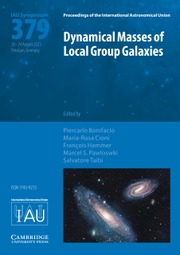No CrossRef data available.
Article contents
Study of centering CCD image of faint satellites near a bright primary object†
Published online by Cambridge University Press: 01 October 2007
Abstract
Core share and HTML view are not available for this content. However, as you have access to this content, a full PDF is available via the ‘Save PDF’ action button.
The polynomial-fit method is applied to remove the uneven background of a satellite when it is near a bright primary object. Detailed analysis of this method is given. Some useful conclusions are drawn from the results of simulated data.
Information
- Type
- Contributed Papers
- Information
- Proceedings of the International Astronomical Union , Volume 3 , Symposium S248: A Giant Step: from Milli- to Micro-arcsecond Astrometry , October 2007 , pp. 138 - 140
- Copyright
- Copyright © International Astronomical Union 2008

